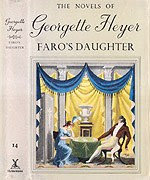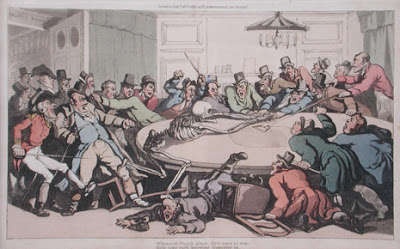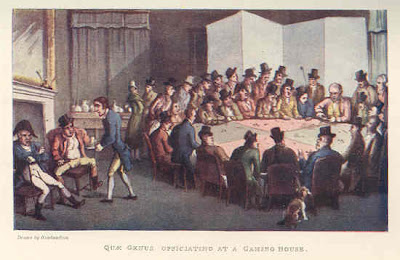 Diane’s post yesterday has me thinking about card-playing again, and my own novel that features the game of piquet, MY LADY GAMESTER.
Diane’s post yesterday has me thinking about card-playing again, and my own novel that features the game of piquet, MY LADY GAMESTER.
The first time I ever heard of piquet was when I read Georgette Heyer’s fabulous FARO’S DAUGHTER, in college. Heyer pulls off a neat (and very difficult) trick in this book — she has a lot of card-playing, and manages to make what is happening clear and interesting to the reader, even if the reader knows nothing at all about the game. “Piqued, repiqued, and capotted” sounded so exciting, even though I had very little idea what it meant!
Unlike Diane, I have long been interested in games, though it’s more a casual interest than anything. (In other words, at parties I’ll play cribbage and hearts, but not bridge, and though I’ve done a little war-gaming in my time, I usually give it a miss, preferring board games and party games.)
 When Todd and I were living in London, we decided to learn piquet. Before long, we were true fans of the game, and developed our own little tricks and strategies. (I gave some of mine to Atalanta, because I know they work!)
When Todd and I were living in London, we decided to learn piquet. Before long, we were true fans of the game, and developed our own little tricks and strategies. (I gave some of mine to Atalanta, because I know they work!)
 Later, I had the opportunity to work with Kristen Skold on writing an understandable “translation” of parts of her Regency-era Hoyle’s, for the Beau Monde’s annual soiree. This was the first time I had to figure out a game not just from a book, but from an awkwardly written, very non-user-friendly Regency book! It was quite a challenge — occasionally too much. (I never did figure out lansquenet — either the version in that book was incorrect, or I was missing something, because what I got from it was quite unplayable.) So now I know how to play cassino, commerce, loo, Pope Joan, speculation, and (theoretically) whist.
Later, I had the opportunity to work with Kristen Skold on writing an understandable “translation” of parts of her Regency-era Hoyle’s, for the Beau Monde’s annual soiree. This was the first time I had to figure out a game not just from a book, but from an awkwardly written, very non-user-friendly Regency book! It was quite a challenge — occasionally too much. (I never did figure out lansquenet — either the version in that book was incorrect, or I was missing something, because what I got from it was quite unplayable.) So now I know how to play cassino, commerce, loo, Pope Joan, speculation, and (theoretically) whist.
 For many games, the only way to really figure out how it’s played (and find out if you’re reading the rules right) is to play it. However, a lot of the games I named above are what Jane Austen called “round games” — and they need more than two players. Luckily, I have plenty of stuffed animals, and they helped me figure out how to play commerce, loo, etc. I would sit them in a circle, deal out a hand to each, and then play each hand in turn. (It’s much easier to remember who did what than if you just deal out hands to nobodies.) In addition, I learned that my hedgehog wearing a Santa hat (which I got for a pound in a cheapo East End Christmas shop) is really good at cards — he kept winning. (Now whenever I see the term “card shark,” I know secretly it should be “card hedgehog.”)
For many games, the only way to really figure out how it’s played (and find out if you’re reading the rules right) is to play it. However, a lot of the games I named above are what Jane Austen called “round games” — and they need more than two players. Luckily, I have plenty of stuffed animals, and they helped me figure out how to play commerce, loo, etc. I would sit them in a circle, deal out a hand to each, and then play each hand in turn. (It’s much easier to remember who did what than if you just deal out hands to nobodies.) In addition, I learned that my hedgehog wearing a Santa hat (which I got for a pound in a cheapo East End Christmas shop) is really good at cards — he kept winning. (Now whenever I see the term “card shark,” I know secretly it should be “card hedgehog.”)
 Eventually, when I was looking for a hook for a new manuscript, I thought, “What do I know particularly well about the Regency? Hmm… Oh, yeah, cards!” And the fair Atalanta was born.
Eventually, when I was looking for a hook for a new manuscript, I thought, “What do I know particularly well about the Regency? Hmm… Oh, yeah, cards!” And the fair Atalanta was born.
Of course, then I had the same task as Heyer: how to explain the card-playing in such a way that it’s dramatic, and works both for those who are Regency card experts, and those who’ve never even heard of piquet or cassino.
It was hard, I admit! My first impulse was to describe too much — but I had a few good critiquers who wrote “huh?’ and the like in the margin whenever the gaming confused or bored them.
Actually, I think the hardest thing for me was to stop pronouncing the game “PICKett” (which I could’ve sworn the first dictionary I checked gave as its pronunciation!) and instead train myself to say piKETT. Oh, well, maybe writing the book was a tad bit harder.
Maybe.
Do, do you like to play card games? Are you a bridge player? Have you ever played piquet?
What are your favorite books that include gambling or cards?
Cara
Cara King, author of MY LADY GAMESTER:
150% More Card-Playing Than the Leading Regency! Guaranteed!

I was a lame rummy kind of person till I got married. Then my husband and his dad introduced me to cassino, the straight version and the dad’s funky rules, which change every time we meet and sit down to play. Cassino is a lot of fun.
Cara, I’m counting on playing Pope Joan in July with you at the soiree. I’ll be sure to bone up on the instructions you sent to me last fall.
BTW, I loved the two-penny whist picture.
Keira-who’s-working-out-hard-at-Curves-to-avoid-curves-just-like-those :O
Oh, Cara! I am a card player from way back! I grew up playing Canasta, Spit, Hearts, Spades, Slapjack, War, Rummy, Gin Rummy (my sister and I had a running game for years. I think I owed her about $1000 – we played a penny a point!)
The family game, still played when my sisters and I get together with our cousins is Shanghai, a rummy game with different criteria for each hand.
I have played a little Bridge. My mother was an avid Bridge player, but I resisted learning, particularly in college because I knew I would never study.
Alas! I married a man who is not a game player of any kind, so I have few opportunities to play. My kids are not card players, although my son could be. He has that spark.
But the instructions for Piquet foxed me. I never thought of stuffed animals, though.
Diane
I’m not much of a card player. We played ‘garbage’ and ‘7 Up’ on New Year’s Eve. We played for pennies and buttons (we’re a family of seamstresses).
We also played Italian card games such as Scopa and another one that begins with a B. My aunt and grandmother would accuse the other of cheating at Scopa when neither one could keep the score straight in their heads. The Piquet cards you displayed are very similar to the cards we use. We also played a board game called ‘Tomba’. It’s kind of like Bingo, only louder.
As to books that feature gambling aside from Diane and Cara, I would have to say one of my favorites is ‘Hazard’ by Jo Beverly. Simply divine.
Keira, I suspect I won’t be at the conference this year! So though I’d adore playing Pope Joan with you, I fear you’ll have to settle for someone who is not-me (though I’m sure any not-me that you play with will be very nice.) 🙂
Diane, I see I misread part of your post — sorry! You are clearly a gamester extraordinaire (with I suspect much more experience than I have), and I have merely the small advantage of being happy to study game rules till my brain turns curlicues.
BTW, Santa, glad you’ve rejoined the Riskies! It’s been a while!
Cara
When I was growing up my parents would play Tripoli with pennies, with family and friends. One night when I was about 10 yrs old, I got up to get a drink of water and couldn’t go back to sleep so they let me play a hand with them and I actually won the pot, which was probably about $2-$3. That is one of my favorite gaming memories :D. Wanda
Cara wrote, “I suspect I won’t be at the conference this year!“
WHAT?! After all chats about the soiree dancing lessons. Betrayal!! Utter betrayal!
To all those of you here at the Riskies who recommended I see the movie Valmont, I raise a bottle of fine Bordeaux and a wheel of pepper-jack cheese to you. We just finished seeing the movie, and now I get why you guys ooh-n-aah about Colin Firth.
See, I was a straight Matthew MacFadyen kinda gal. Then you guys said I should watch the BBC miniseries. But I still didn’t get in. Rest assured, I now do get it.
Keira-Doh!
Wow, what great pictures, Cara! I really enjoyed looking at this post almost as much as reading it.
Since I was the victim of Cara’s quest to master the rules of piquet (she used to beat me with a stick on a regular basis), I am glad that the effort proved useful in constructing the card-playing scenes in My Lady Gamester. Piquet is a great game! Though nicer when you win.
And I can also confirm that the hedgehog plays a mean game of Loo and Cassino.
Todd-who-can-still-vividly-remember-the-humiliation-of-being-bested-by-a-six-inch-stuffed-hedgehog-in-a-Santa-hat
Cara, you did a great job in MLG because I am clueless about Regency card games (hanging head in shame) and those scenes were still engrossing.
I used to play cards with my grandparents: gin rummy and several Lithuanian games which may be version of more familiar games but I don’t know! One was called “Melagis” which means “liar”. It was some sort of a bluffing game. The other was a 4-player game called “Malunas” which means “windmill”.
But I’ve forgotten how to play these and somehow doubt either Melagis or Malunas were popular in Regency England…
Someday Cara will have to induct me back into the pleasures of cards. And give me an education in proper tea drinking too. 🙂
Elena
Todd,
Shame on you. You should consider it a privlege to have a wife who wants to play with you! (um….I don’t think that came out right….) You know what I mean. CARDS.
Santa, I agree, good to see you.
Wanda, I don’t know the game Tripoli, but I love the memory. I think my mother and aunt (who lived with us growing up)were delighted when my sisters and I learned to play cards. My dad was also Not A Card Player.
I’ve never played cards at the Soiree, but only because Amanda made me dance with her.
And I agree, Cara, we’ll miss you at the soiree!
Diane
What great pix, Cara.
I’m so impressed with anyone who can keep complex sets of game rules in their heads. The copy editor of my first published romance, ALMOST A GENTLEMAN, almost had apoplexy trying to understand what I was doing in the whist scene (to fix the scene, I sent my husband to the web to learn the rules, and to drive the essentials of the game into my head we had the neighbors in for cards). In the book I’m working on now, I think I may include a game of hazard — very much the thing at Crockford’s in the later years of the Regency and easy enough even for me to grasp.
What a wonderful post Cara, I also never got a chance to say how much I loved your Regency dress and pictures from a couple posts ago! :)You looked very beautiful!
I love cards. I read some books with card playing in them but don’t remember the titles of those off hand.
I learned playing cards from James many many years ago. Last time I played any cards was back home in London.
Oh, I love the idea of the card hedgehog!
I believe the French say Piquet as “pee-kay” while the English say it as spelled
since I am all about the strip card games, my favorite Sabrina Jeffries novel — ONE NIGHT WITH A PRINCE — has a game of Strip Whist. I recommend it 🙂
First, before I forget, oh yeah, I forgot about One Night with a Prince. . . LOL but before I got that far in the comments, I was thinking that I think for the most part, the only books that have mentions of cards, from just a mention to something like My Lady Gamester where it’s a bigger part is Regencies. But then I’m a mostly historical reader and just might not have hit on contemporaries that have people who gamble much. LOL 🙂
As for me, I’m a computer card game player. LOL Not pay sites, no way. . . but on my ancient pda at one time or another, solitaire, blackjack, poker, and all around casino programs. I don’t think I would ever have the guts to actually go into a casino or something, but I like doing the games. 🙂
Lois
What a wonderful post Cara, I also never got a chance to say how much I loved your Regency dress and pictures from a couple posts ago! :)You looked very beautiful!
Thanks so much, Mallory! You’re very kind. 🙂
As for computer card games, I fear I like some of them rather too much. I have such a craving to play solitaire on Todd’s pda that he has to hide it from me most of the time or I’d never get any work done. 🙂
Cara